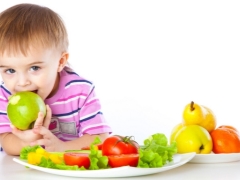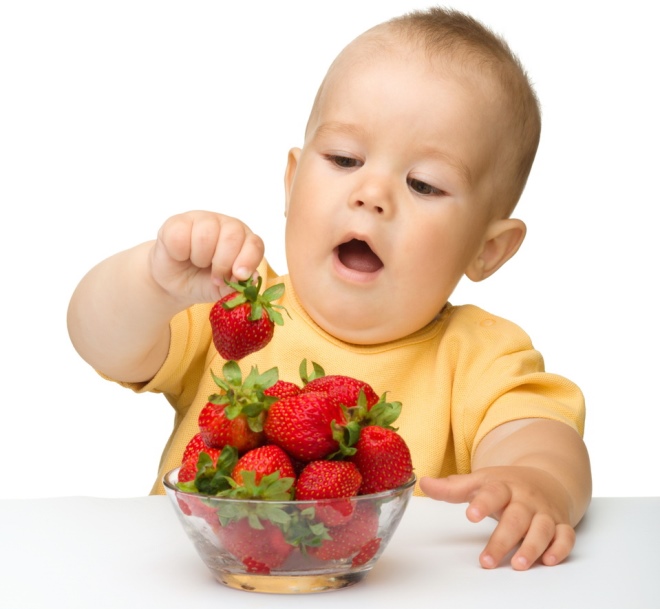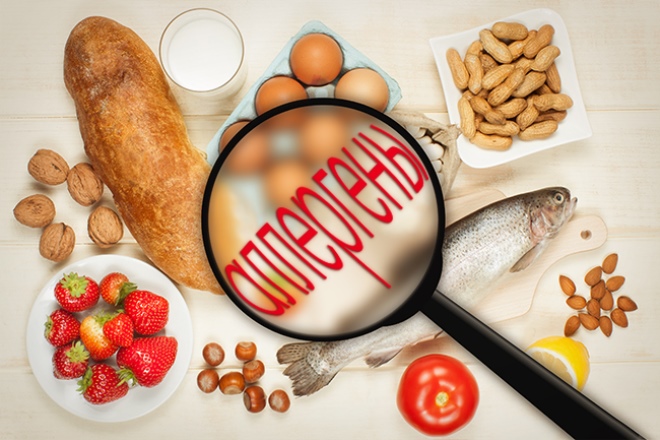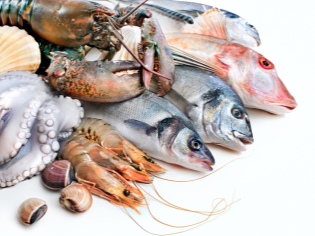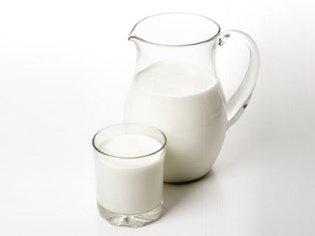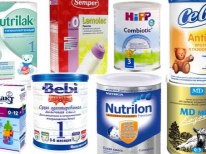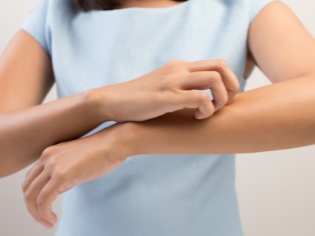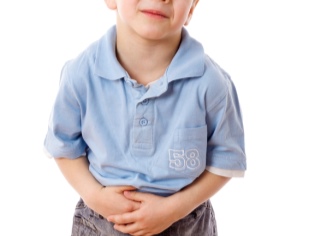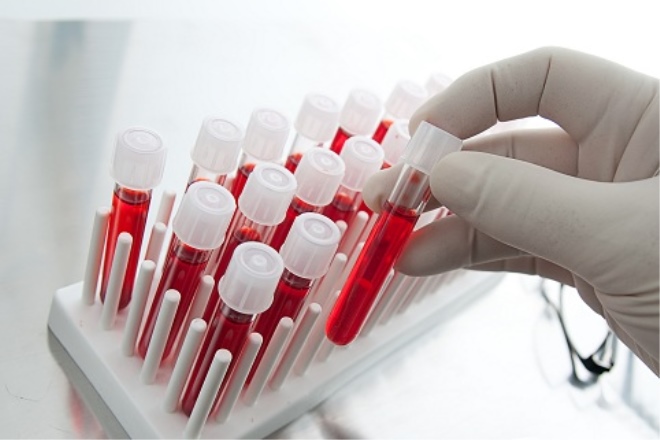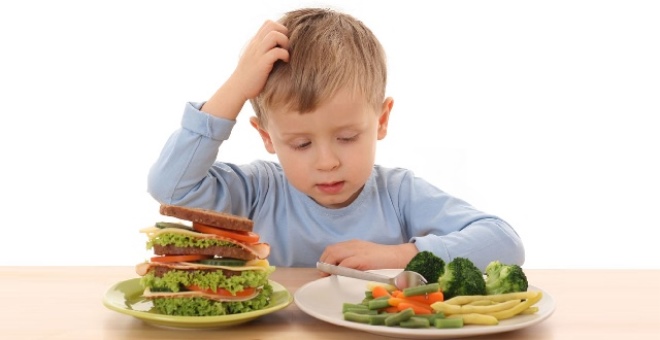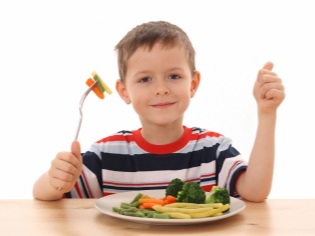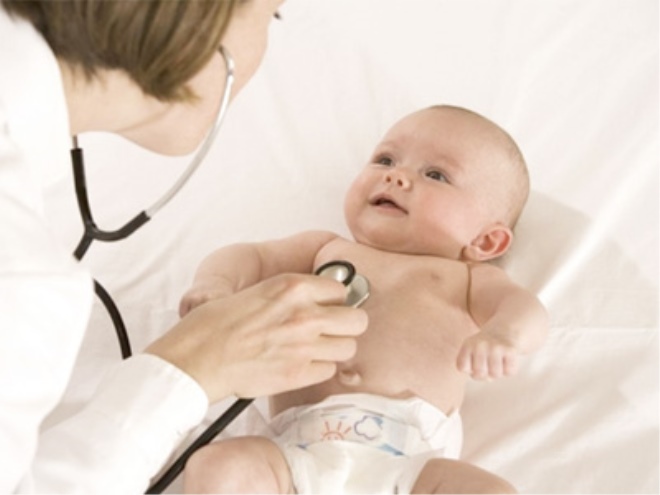Food allergies in a child
Severe itchy rashes occur when various allergenic products are ingested. This condition is very dangerous development of adverse effects that can greatly impair the health of the child. Food allergy in a child is something that parents should pay close attention to.
What it is?
The development of allergic rashes that appear on the skin after consuming certain foods is called food allergies. This condition is equally common in both boys and girls.
Every third child with allergies has food allergies. Adverse symptoms can occur at any age. Even within 1 year after birth, babies may experience allergic manifestations.
How does it come about?
The provoking factors in this form of allergy are various products that have a strong allergenic effect. Allergens entering the body pass through the gastrointestinal tract and are easily absorbed. Once in the bloodstream, the foreign components are recognized by cells of the immune system.
Contact with the allergen provokes the onset of a cascade of inflammatory reactions. During their development, a huge amount of biologically active substances is released. A specific sign of allergy is an increase in the level of immunoglobulin E. Normally, the amount of this substance is always the same. An increase in the level of immunoglobulin E may indicate the development of an allergic reaction.
Other substances that also contribute to inflammation are bradykinin and histamine. They affect the tone and diameter of blood vessels. The increased concentration of such substances leads to a strong spasm of peripheral arteries, which contributes to a sharp decrease in blood pressure and impaired contractile function of the heart.
Biologically active substances formed during an allergic reaction, have an adverse effect on the organs of the gastrointestinal tract. This leads to digestive disorders, as well as a decrease in the motor function of the intestine. If the allergens are not timely removed from the body, adverse symptoms may persist for a long time.
The reasons
Food allergy products are quite a lot. Often, a provocative factor that triggers an allergic process becomes some substance with pronounced antigenic properties.
Among the most common causes of food allergies:
- Citrus and other tropical fruits. Extractive substances and fruit acids have pronounced allergenic properties. Even a small amount of such exotic fruits contributes to the appearance of adverse allergies.
- Seafood. Many mothers for the first time add them to the children's diet in 3-4 years. It is at this time that the first signs of allergy are most often recorded. Very often, seafood causes angioedema. Even cases of anaphylactic shock have been reported.
- Chocolate and all sweets composed of cocoa beans.
- Cow Milk Protein. 50% of American children have an increased sensitivity and intolerance to this product.Usually the first signs of the disease develop in the first year of a child’s life. At this time, many moms dilute adapted milk with cow's milk or boil milk porridges on it.
- Products containing gluten. This vegetable protein is found in wheat flour, as well as in many cereals. The entry of gluten into the intestine leads not only to the development of symptoms of celiac disease, but also to the appearance of an allergic reaction.
- Berries and fruits are red and yellow. They contain many plant coloring pigments that contribute to the development of allergies. These components have a high allergenic effect. Even vegetables of yellow and red colors should be introduced into the diet of a child with a predisposition to allergies very carefully and gradually.
- Food Made by Industrial. Typically, these finished products contain too many additional flavors and spices. These components have a pronounced sensitizing effect on the immune system, provoking the development of food allergies.
- Sweet carbonated drinks. To impart a beautiful color, dishonest manufacturers often add low-quality dyes. Such components not only contribute to the appearance of allergic reactions in babies. With long-term use, they can have a toxic effect on the liver and pancreas.
- Mom's poor diet during lactation. In infants, food allergies can develop as a result of the ingestion of allergens along with mother's milk. If a nursing mother eats foods with a high allergenic effect, then the risk of diathesis or the appearance of adverse symptoms of atopic dermatitis in a child increases several times.
- Use of improperly selected blends. Some adapted mixtures can cause allergies in your baby. The more ingredients are included in the composition of these products, the harder it is to understand which of them caused allergies. The most often adverse allergy symptoms are caused by mixtures containing dry cow's milk or gluten.
- Chicken and quail eggs. If a baby has chicken intolerance, then in 80% of cases he will also have an increased risk of developing allergic reactions when eating eggs.
- The nuts. Any species can cause allergies. Even a small amount of chopped nuts, included in various ready-made breakfast cereals or nutritious sweet bars, contributes to the development of food allergy symptoms. In America, marking is surely put even about the presence of traces of nuts in all products that can be purchased at the supermarket.
Symptoms
Food allergies manifest themselves in different ways. The severity of symptoms depends on the age of the child, the initial state of immunity, as well as the presence of concomitant chronic diseases.
The most characteristic signs of food allergies:
- Red itchy spots or blisters all over the body. In young children, this symptom appears quite clearly. The skin looks inflamed and with multiple marks of scratching.
- Unbearable itching. It occurs both in the daytime and at night. May increase after bathing or when water gets on skin. At night, itching is slightly reduced.
- Great weakness. Persistent itching severely exhausts the baby. He becomes more lethargic, refuses to eat. The child's appetite is getting worse. With a long course of food allergy, babies begin to lose weight.
- Stomach ache. There is not always. Pain occurs in the presence of associated diseases of the gastrointestinal tract.
- Disruption of the bowel. Often manifested by the appearance of loose stools. Some babies have alternating diarrhea and constipation.
- Fast fatiguability. The child plays less active games, rests more often.Due to severe itching and disturbed sleep, there may be a decrease in activity during the daytime.
- Edema. Often occur on the face and neck. Most characteristic of angioedema. This symptom is very unfavorable. With the appearance of swelling on the face and swelling of the eyes, you should immediately show the baby to the doctor. Home treatment in this case can be dangerous.
Diagnostics
To accurately identify which product is allergen for a baby, additional examinations are required. For the purpose of such tests, parents should show the baby to an allergist. The doctor will examine the child, as well as perform diagnostic studies that will help determine all the causes of allergy.
Currently, the following methods are used to diagnose food allergies:
- General blood analysis. With allergies, the number of leukocytes increases and the ESR increases. The number of lymphocytes and eosinophils increases in the leukocyte formula. These cells are responsible for the development of allergic reactions in the body.
- Blood biochemistry. Allows you to establish comorbidities that occur with similar symptoms. For differential diagnosis, the level of bilirubin, hepatic transaminases, alkaline phosphatase and amylase is determined. These indicators characterize the work of the liver, gallbladder and pancreas.
- Determination of the level of immunoglobulin E. At each age there are certain norms of this substance. All laboratories also propose their normal values of the index (based on the reagents used to perform the analyzes). During allergic reactions, the level of immunoglobulin E increases several times.
- Allergen Panel Detection. These types of studies help identify all possible allergenic substances that can cause allergic manifestations. The material for the study is venous blood. The term of readiness of the analysis is from three days to a week. This lab test is very informative and reliable.
- Scarification tests. Conducted for toddlers of school age. In early childhood, this test is difficult and does not have high reliability of the result. A special tool the doctor makes notches on the skin of the child, introducing diagnostic allergens that correspond to specific products. When a bright red spot appears in the area of certain cuts, one can speak about the presence of high sensitivity to this allergenic substance.
- Bakposelev feces. Appointed in the case of persistent violations of the chair. The analysis is performed within 7-14 days. With this test, you can establish the presence of dysbacteriosis in the intestines, which often develops with prolonged food allergies.
Treatment
For the treatment of food allergies used several methods. Completely get rid of this disease is impossible. Food allergies will remain with the child for the rest of their lives. Monitoring the development of new exacerbations of the disease should be constant.
In identifying food allergies in the baby, doctors recommend:
- Follow hypoallergenic diet. All products that have strong allergenic properties are completely excluded from the baby’s diet. Follow the recommendations on nutrition should be throughout life.
- The appointment of gastrointestinal drugs. Such drugs help to eliminate the adverse symptoms that occur in the stomach or intestines after consuming allergenic products. Drugs can be prescribed as a course intake (to relieve adverse symptoms of exacerbation), and permanent. Such medicines help to normalize the motor function of the intestines and improve digestion.
- Normalization of the day regimen. Full and high-quality sleep is very important for the rapid recovery of the child's body.Kids must rest in the afternoon at least 2-3 hours. At night, the baby should sleep around 9 o'clock.
- Purpose of antihistamines. Helps to eliminate the adverse symptoms of itchy skin and improve baby's well-being. Apply only in the acute period of allergy.
- Restorative therapy. Reception of multivitamin complexes, active walks in the fresh air, restriction of mobile games in the acute period of the disease contribute to a more rapid recovery of the body.
- Refusal from artificial feeding and transition to other adapted mixtures. As a part of such products there are usually a lot of different components. With the development of food allergies should find out which component of the mixture the baby has food allergies. In the future, it will help to choose a more suitable product.
Drug therapy
To eliminate the adverse symptoms that bring the child pronounced discomfort in the acute period of the disease, doctors recommend the following groups of drugs:
- Antihistamines. Can be used in the form of tablets, ointments, creams, as well as through injections. They are usually prescribed for 5-7 days - to relieve discomfort symptoms. Helps to eliminate pronounced itching and normalize sleep. They are usually used 1-2 times a day. For the treatment of food allergies, you can use the following tools: «Claritin"," Suprastin ","Loratadine"," Zyrtec "," Erius " and many others.
- Hormonal. Often used in severe illness and to eliminate itchy skin rashes. Treat hormones with the help of hormones at any age. The effect of such funds lasts, as a rule, for a long time. With prolonged use, systemic side effects may occur. When they appear, hormonal drugs are canceled.
- Soothing. They help to normalize sleep, and also help to reduce increased anxiety resulting from prolonged and painful itching. For children, preferred broths and infusions prepared from medicinal plants at home. At an older age, you can use drops containing plant extracts. Melissa, mint, oregano have a sedative effect.
- Healing creams and ointments. They contain active ingredients with antihistamine and anti-inflammatory action. Apply topically to the area of inflamed skin. Can be used for a long time. Helps to eliminate itchy skin elements, as well as helps soften and moisturize the skin.
- Multivitamin Complexes. They help to restore the immune system and strengthen the children's body weakened during the period of exacerbation of allergy. Appointed for 1-2 months. Allowed exchange intake of multivitamin drugs twice a year - to strengthen the immune system.
- Drugs that affect intestinal motility. In case of severe liquid stools, sorbents are prescribed. Usually, 2-3 hours of reception is enough to achieve the result. During the use of sorbents should drink plenty of fluids. This contributes to the best work of drugs and the rapid achievement of the effect.
Diet
The diet of the baby with food allergies must be carefully planned. Even a small amount of allergenic products should not be allowed into the baby plate. Any violation of the diet contributes to the development of new adverse symptoms of allergies.
Medical nutrition of a child with food allergies suggests a completely varied and tasty menu. Moms should remember that all the products that are allowed to use can be prepared in a variety of ways. Many vegetables perfectly complement each other, you can create very tasty and diverse combinations.
For babies with food allergies, highly allergenic foods should be completely excluded.These include red meat and poultry, bright berries and fruits, seafood and fish, citrus fruits, nuts, chocolate, and tropical fruits. Orange vegetables can also cause adverse symptoms in a child.
The safest zucchini, squash, broccoli, cauliflower, cucumbers, white fish varieties, chicken breast, green apples and pears. There are almost no allergens in these products. They can be safely added to the children's diet - without fear that allergies may develop. Allergic reactions to these products are very rare.
For cooking porridge you can use goat milk. Such a solution would be an excellent option if the usual options are impossible. Porridge and sour milk cooked with goat milk, like most kids. Such products will be an excellent addition to the menu of a child in 1-2 years.
If your baby has gluten intolerance, then you should completely eliminate from the menu all the products that can contain it. Regular wheat pastries can cause severe allergies in a child. It is better to give preference to alternative cereals and cereals, which do not contain gluten. To eat porridge from oatmeal to such babies should not be, as this can lead to the appearance of allergic rashes.
How to keep a food diary?
To identify all possible allergens that can cause food allergies, you should carefully monitor everything that happens to the baby on a plate. To simplify such control can diary nutrition. It should record all the products that are part of the prepared daily meals.
Such records will help identify all the products that cause the child to develop allergy symptoms. When they occur, make notes in the nutrition diary, indicating exactly what symptoms appeared. Such records will also help the allergist to make detailed recommendations on nutrition.
Keep a diary should be constantly. Keeping such records is especially important in the first three years of a child’s life. At this time, the final formation of eating behavior takes place, and practically all basic foods are introduced into the baby’s diet. Keeping a diary at an older age will allow you to identify other allergens that can cause a child to develop adverse symptoms.
Urgent Care
When the first symptoms of allergy appear, the child should be shown to the pediatrician. Often, allergic manifestations are similar to similar symptoms that occur in various diseases of the gastrointestinal tract. The doctor will perform an examination and prescribe tests that will help determine the exact cause of the disorder.
To eliminate the allergen from the body, you should wash the mouth with ordinary boiled water. In the hospital resorted to gastric lavage. Typically, this procedure is performed only when symptoms of the disease are expressed. If the baby has abdominal pain and severe stool disorder, then sorbents can be used. They quite effectively help cure everything.
To eliminate itching should be given to the child. antihistamine. Usually, before a medical examination, you should not give more than one tablet. This dosage is sufficient to reduce the adverse symptoms. In some cases, doctors recommend giving the child an enema. It also helps to eliminate allergens from the body.
To improve well-being, you should give your baby as much as possible. more fluid.
In case of food allergies, it is better to feed the child with ordinary boiled water, cooled to room temperature. When the symptoms of allergy increase, you should definitely call a doctor or an ambulance brigade. With the development of angioedema or anaphylactic shock may require emergency hospitalization of the baby in the hospital, where he will be helped by experts.
Prevention
In order to avoid adverse symptoms of food allergies, prophylactic measures should be observed.All rules must be strictly followed, without exception. Any ingestion of even the smallest amount of allergen in the body can contribute to the deterioration of health.
To avoid food allergies, you should:
- Control diet. Adherence to the hypoallergenic diet contributes to the good functioning of the immune system and excellent digestion. The exclusion of allergenic foods helps to maintain a familiar lifestyle and avoid the appearance of adverse symptoms.
- Strengthen immunity. Good nutrition, 9-hour sleep, outdoor play and hardening help to normalize the immune system.
- Exclude highly allergenic foods from the diet during pregnancy and lactation. Even small indulgences can lead to the development of severe atopic dermatitis or diathesis in a child. Future mothers (as well as women who are breastfeeding) should always keep a nutrition diary. It will list all the products that were consumed during the day. Such records will help moms more easily determine what contributes to the development of food allergies in babies.
Regularly observed by an allergist. All babies with food allergies should be screened to identify the panel of allergens. This test will allow to identify all possible and even hidden allergenic products that can lead to the development of food allergies.
- Monitor skin hydration. During the period of exacerbation of food allergies, the skin becomes very dry. After baths or showers, dryness may increase markedly. To moisturize the skin, you can use special moisturizers - emolent. They should be applied 2-3 times a day. These tools can be used for a long time.
- Restriction of hygiene procedures. During the exacerbation of allergies, the baby should not be long in the water. 10-15 minutes is usually enough. Longer hygienic procedures can enhance the itching and the appearance of new rashes on the skin. After a bath or shower, apply a remedy or ointment to the inflamed areas and leave them until completely absorbed.
Regular monitoring of the course of food allergies prevents the development of the disease. Dieting and strengthening the immune system will significantly reduce the risk of exacerbations in the future.
About why food allergies appear, see the explanation from Dr. Komarovsky in the next video.
